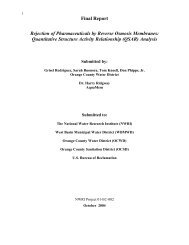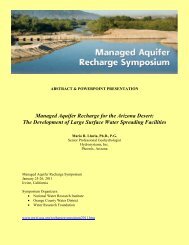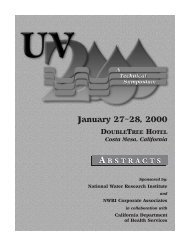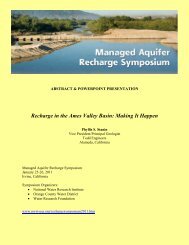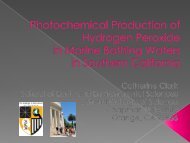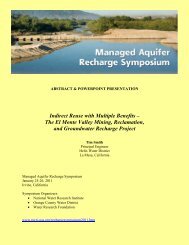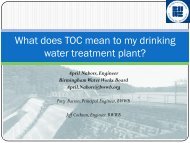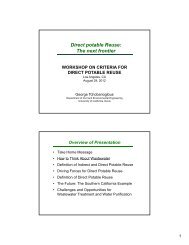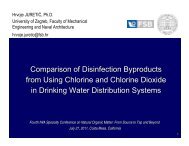RBF_Cover (for eps) - National Water Research Institute
RBF_Cover (for eps) - National Water Research Institute
RBF_Cover (for eps) - National Water Research Institute
You also want an ePaper? Increase the reach of your titles
YUMPU automatically turns print PDFs into web optimized ePapers that Google loves.
52<br />
contains the lowest concentration of wastewater indicators. For example, Figure 2 shows the<br />
B concentration and the proportions of treated wastewater in surface water in September 2002. The<br />
influence of the Nordgraben extends to transect Tegel Lake, while the field site Wannsee Lake is<br />
under the influence of the Teltow Canal. The percentage of treated wastewater is higher during<br />
the summer months, when the Ruhleben Treatment Plant discharges into the Teltow Canal.<br />
Figure 2. (a) Percentage of treated wastewater in surface water (calculated with discharge only; evaporation,<br />
storage changes, and precipitation neglected). (b) Boron concentration indicating the influence of<br />
the Teltow Canal in the south and Nordgraben in the northeast <strong>for</strong> September 2002.<br />
By combining the results of the discharge measurements with the concentrations of wastewater<br />
indicators, proportions of treated wastewater can be calculated with a mixing <strong>for</strong>mula <strong>for</strong> each<br />
sampling point. In Figure 3, results are shown <strong>for</strong> Tegel Lake in front of the transect. In October<br />
2001, a pumping device started operation, which pumps Havel River water into the PEA-Tegel, a<br />
phophate elimination plant (see Figure 1), when the natural discharge of the Nordgraben is very<br />
low in summer. This led to a strong decrease of treated wastewater in Lake Tegel near the transect<br />
(from 33 to 46 percent [Fritz, 2002] to an average of 11.7 +/– 1.9 percent). For surface water near<br />
transect Wannsee Lake, values of 20.1 percent in the summer (when Ruhleben discharges into the<br />
Teltow Canal) and 8.5 percent in the winter were calculated.<br />
Bank-Filtration System (Wannsee Lake)<br />
At Wannsee Lake, two transects exist, running perpendicular to the shore of Wannsee Lake<br />
between drinking-water Production Wells 3 (TS Wannsee 2) and 4 (TS Wannsee 1). The wells<br />
of the local gallery (Beelitzhof) have several filter screens in different porous aquifers separated by<br />
aquitards. A schematic overview is given in Figure 4. Also shown are the T and 4 He concentrations<br />
originating from hydrogen bomb testing in the 1960s, as well as uranium and thorium decay<br />
within the aquifer. In the two deeper aquifers, groundwater is considerably older than 50 years,<br />
since T is already decayed and the 4 He values are high. In contrast, the shallow wells reflect the<br />
present atmospheric concentrations of T, while 4 He could not be detected. The resulting age is less<br />
than the detection limit of 3 months. The production well is a mixture of all aquifers.



